Frontier Battles:
The Royal Saxon Army Corps
by Mike Bennighof, Ph.D.
March 2019
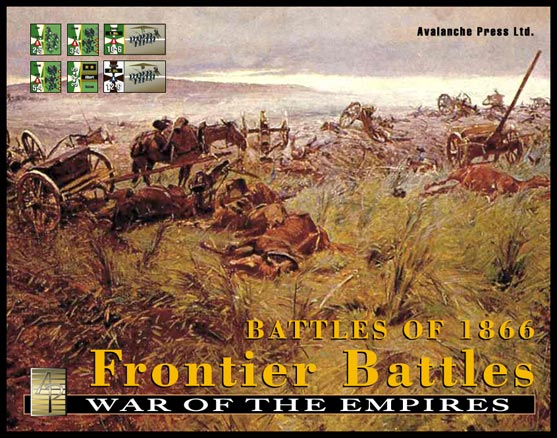 In the 20th Century, Germans would earn a number of reputations, many of them not particularly flattering. Among them came the notion – despite catastrophic defeats in both World Wars - that Germans are good at making war. In the 20th Century, Germans would earn a number of reputations, many of them not particularly flattering. Among them came the notion – despite catastrophic defeats in both World Wars - that Germans are good at making war.
A century earlier, few Europeans would have classed the Germans as a people well-versed in the art of war. Massive defeats in the Napoleonic Wars brought the legacy of Frederick of Prussia crashing down; the smaller German states were seen as even worse in matters military.
The Congress of Vienna left Germany divided, but did re-organize the hundreds of small principalities (many with tiny “armies” of a dozen men or less) into a somewhat more rational system. One of the larger states to emerge from the peace was the Kingdom of Saxony.
The Saxon Army took the field in 1866 aligned alongside Austria against their hated Prussian neighbors. Noted for fine cavalry in the Napoleonic period but little else, the Saxon forces had greatly improved over the last 50 years. An excellent military academy had been opened in Dresden, and professional officers, many drawn from the middle class, replaced the aristocratic scions of most other armies. Saxony sided with Austria during the pre-war political battles, pushing the Habsburg position even harder than the Austrians themselves. Saxony’s military and political leaders showed themselves eager to make war on Prussia, looking to regain some of the lands lost in 1815, and the army’s rank and file echoed their enthusiasm.
The Saxons appear in one of the battles from our Battles of 1866: Frontier Battles game, Jicin. Officially, the Saxon Army made up the X Army Corps of the German Federation’s army. No one used this designation in 1866, and the force was always called the “Royal Saxon Army Corps.” A Federal German corps on paper had four divisions, but like a Prussian formation, the Saxon corps had two divisions, each of two brigades. Each brigade had five battalions (four line and one rifle), the same as a Federal German brigade but smaller than an Austrian or Prussian brigade (seven battalions for an Austrian brigade, six for a Prussian brigade).
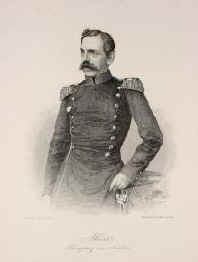 Crown
Prince Albert
Crown
Prince Albert
of Saxony; greater
reputation than talent |
|
Unique among the German armies, Saxony had no regiments: its sixteen infantry battalions were independent, numbered 1 through 16 with the rifle battalions numbered 1 through 4. The 13th through 16th battalions made up the Leib (“Guards”) Brigade and performed ceremonial duties during peacetime but were not usually considered elite.
Saxon soldiers carried the same Lorenz muzzle-loading rifles as their Austrian allies, but Saxon doctrine called for “outmoded” tactics compared to the Austrian army’s brutal stosstaktik. Austrian units formed massive assault columns, 60 men wide and 12 deep, and suffered terribly from Prussian rifle fire. The Saxons used the linear tactics of the late Napoleonic period, with much better effect. The Saxon corps saw as much action at Königgrätz as most of the Austrian corps, but suffered fewer losses than any equivalent Austrian formation. The wrecked Austrian IV Corps lost roughly seven times as many men as the Saxons.
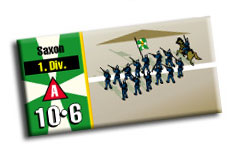
The Saxon Divisions
Saxony’s investment in a modern military academy paid off in 1866; the infantry proved well-led at the brigade and battalion level. Corps command suffered thanks to the dynasty’s political need to put one of its own in charge. Crown Prince Albert had strong personal connections to the Austrian court and most of its military leadership. Albert didn’t attend the Saxon military academy and the difference showed in his indecisive leadership at Gitschin in 1866. Austrian North Army commander Ludwig von Benedek felt that he had to defer to the Saxon prince, and invited disaster by giving him an independent command in Bohemia. Albert would emerge from the war with a soaring military reputation, but it was one earned by the stern performance of his troops and junior officers.
About half of the Saxon artillery batteries had new Krupp steel breech-loading pieces; the remainder took heavy smooth-bore muzzle-loading cannon into battle. Saxon artillerymen proved better than the Prussians but not up to the standards of their Austrian allies; when the Austrian gunners made their final stand at Königgrätz the gun line included a number of Saxon pieces manned by Austrian crews after the Saxons had abandoned them.
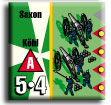 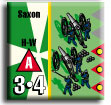
The Saxon guns
Saxony’s famous cavalry had lost its edge by 1866, but most Saxon generals had come up as cavalry officers and so the branch remained numerically very strong. The corps brought along a full division of cavalry, just over 2,000 light cavalrymen. While the Saxon infantry earned a good reputation in the 1866 campaign, the cavalry made no contribution. They did not participate in the scouting and screening activities of their Austrian counterparts, nor did they take part in the fatal final charge of the Austrian cavalry reserve at Königgrätz. Where the Austrian horse suffered terrible casualties, their Saxon comrades gave the American Civil War infantry’s complaint of “who ever saw a dead cavalryman?” a Central European equivalent.
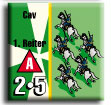
The famed Saxon Horse
Austria and Saxony conducted little pre-war planning, and when war broke out the Saxon plan at first had the corps marching to the south-west to link up with the Bavarians. When Bavarian mobilization proved very slow, Albert and his father, King John, decided to answer Austrian requests to move into Bohemia to link up with the Austrian forces there. River steamers on the Elbe helped shift Saxon supplies and equipment, and the corps managed to make the move without encountering the Prussians.
Albert enjoyed great prestige at the Austrian court, and Benedek may have been directed to give the crown prince the command in Bohemia as a quid pro quo for the Saxons moving their forces into Austria. Some among the Austrian leadership had also hoped to bring the Bavarian army into the theater to form an army of about 100,000; placing a German prince in command would emphasize the German nature of the Austrian war effort. Benedek declined Bavarian aid, and Albert performed unevenly – handling the early moves in Bohemia fairly well, but causing disaster at the Battle of Gitschin thanks to his dilatory responses.
In game terms, the Saxon corps is a good formation but no better led than most Austrian corps. It is immune to the Austrian military culture special rules requiring Austrian infantry to assault its enemies in some circumstances, which is useful. The infantry brigades have a little less staying power than an Austrian brigade, but don’t always need it thanks to their generally stouter morale. On the other hand, the Saxon cavalry and artillery is not nearly as good as that of the Austrians, but no worse than their Prussian enemies.
Fight with the Saxons! Order Frontier Battles right now!
Sign up for our newsletter right here. Your info will never be sold or transferred; we'll just use it to update you on new games and new offers.
Mike Bennighof is president of Avalanche Press and holds a doctorate in history from Emory University. A Fulbright Scholar and award-winning journalist, he has published over 100 books, games and articles on historical subjects.
He lives in Birmingham, Alabama with his wife, three children and his dog, Leopold.
|
